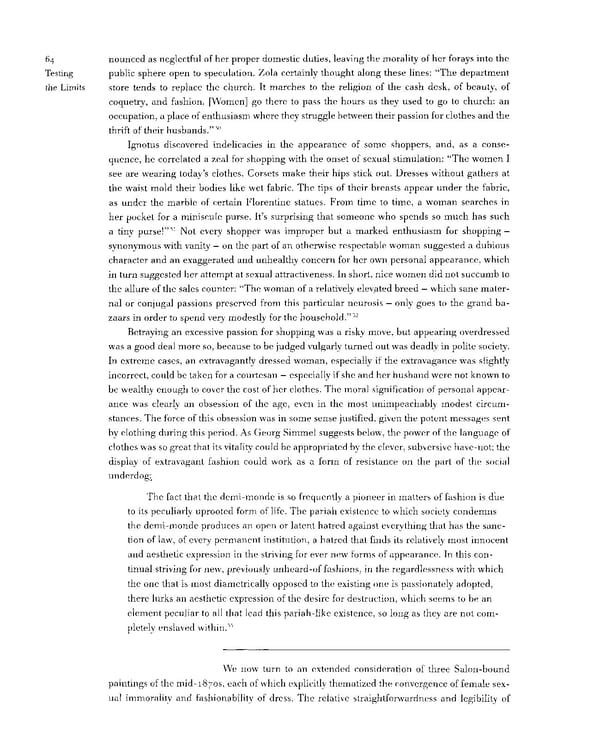64 nounced as neglectful of her proper domestic duties, leaving the morality of her forays into the Testing public sphere open to speculation. Zola certainly thought along these lines: "The department the Limits store tends to replace the church. It marches to the religion of the cash desk, of beauty, of coquetry, and fashion. [Women] go there to pass the hours as they used to go to church: an occupation, a place of enthusiasm where they struggle between their passion for clothes and the 30 thrift of their husbands." Ignotus discovered indelicacies in the appearance of some shoppers, and, as a conse- quence, he correlated a zeal for shopping with the onset of sexual stimulation: "The women I see are wearing today's clothes. Corsets make their hips stick out. Dresses without gathers at the waist mold their bodies like wet fabric. The tips of their breasts appear under the fabric, as under the marble of certain Florentine statues. From time to time, a woman searches in her pocket for a miniscule purse. It's surprising that someone who spends so much has such 31 a tiny purse!" Not every shopper was improper but a marked enthusiasm for shopping — synonymous with vanity - on the part of an otherwise respectable woman suggested a dubious character and an exaggerated and unhealthy concern for her own personal appearance, which in turn suggested her attempt at sexual attractiveness. In short, nice women did not succumb to the allure of the sales counter: "The woman of a relatively elevated breed — which sane mater- nal or conjugal passions preserved from this particular neurosis — only goes to the grand ba- 32 zaars in order to spend very modestly for the household." Betraying an excessive passion for shopping was a risky move, but appearing overdressed was a good deal more so, because to be judged vulgarly turned out was deadly in polite society. In extreme cases, an extravagantly dressed woman, especially if the extravagance was slightly incorrect, could be taken for a courtesan — especially if she and her husband were not known to be wealthy enough to cover the cost of her clothes. The moral signification of personal appear- ance was clearly an obsession of the age, even in the most unimpeachably modest circum- stances. The force of this obsession was in some sense justified, given the potent messages sent by clothing during this period. As Georg Simmel suggests below, the power of the language of clothes was so great that its vitality could be appropriated by the clever, subversive have-not; the display of extravagant fashion could work as a form of resistance on the part of the social underdog:. The fact that the demi-monde is so frequently a pioneer in matters of fashion is due to its peculiarly uprooted form of life. The pariah existence to which society condemns the demi-monde produces an open or latent hatred against everything that has the sanc- tion of law, of every permanent institution, a hatred that finds its relatively most innocent and aesthetic expression in the striving for ever new forms of appearance. In this con- tinual striving for new, previously unheard-of fashions, in the regardlessness with which the one that is most diametrically opposed to the existing one is passionately adopted, there lurks an aesthetic expression of the desire for destruction, which seems to be an element peculiar to all that lead this pariah-like existence, so long as they are not com- 33 pletely enslaved within. We now turn to an extended consideration of three Salon-bound paintings of the mid-18705, each of which explicitly thematized the convergence of female sex- ual immorality and fashionability of dress. The relative straightforwardness and legibility of
 Prostitution & Impressionists Page 84 Page 86
Prostitution & Impressionists Page 84 Page 86